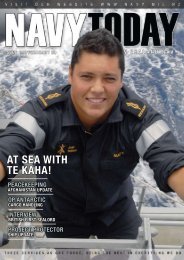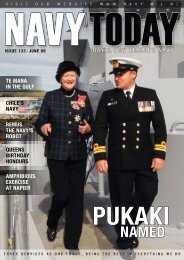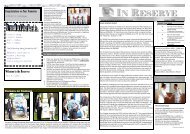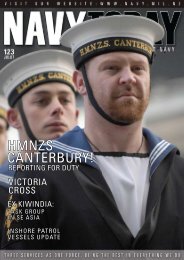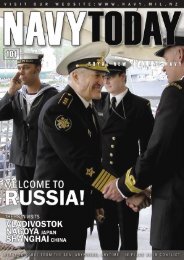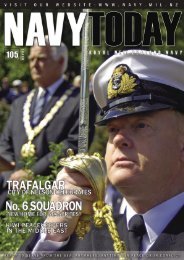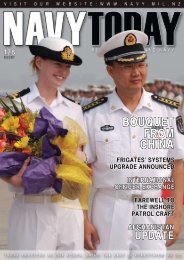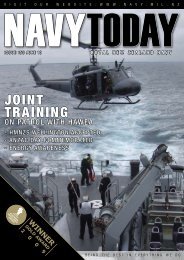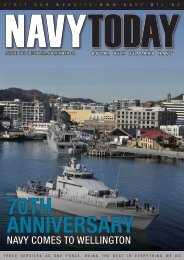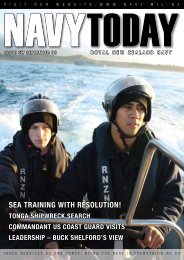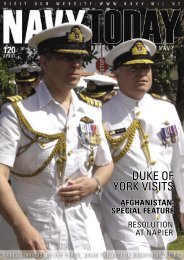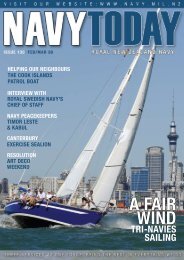You also want an ePaper? Increase the reach of your titles
YUMPU automatically turns print PDFs into web optimized ePapers that Google loves.
Photos TE KAHA<br />
A DAY <strong>IN</strong> THE LIFE<br />
BY LET WARRICK HUNTER AND LET ANGELA BASHAM, FIRE CONTROL OFFICERS<br />
FIRE CONTROLLERS<br />
<strong>IN</strong> TE KAHA<br />
OUR FRIGATE TE KAHA IS<br />
CURRENTLY <strong>IN</strong> EAST ASIAN WATERS,<br />
HEAD<strong>IN</strong>G TO JAPAN AND CH<strong>IN</strong>A<br />
AFTER A SERIES OF EXERCISES WITH<br />
OUR FPDA PARTNERS. THE SUCCESS<br />
OF THE FRIGATE’S ACTIVITIES<br />
DEPENDS <strong>IN</strong> LARGE PART ON<br />
THE PEOPLE OF THE WEAPON<br />
ENG<strong>IN</strong>EER<strong>IN</strong>G DEPARTMENT,<br />
WHO KEEP THE GUNS, RADARS<br />
AND ALL THE OTHER EQUIPMENT<br />
ON TOP L<strong>IN</strong>E. TWO OF TE KAHA’S<br />
ELECTRONIC TECHNICIANS GIVE AN<br />
<strong>IN</strong>SIGHT TO A DAY <strong>IN</strong> THEIR LIFE.<br />
WHAT IS A WARSHIP?<br />
LET Hunter with one of TE<br />
KAHA’s 50 cal machine guns<br />
The frigates are the pride of our <strong>Navy</strong> - the<br />
jewels in the crown of our war-fighting capability.<br />
To see TE KAHA in her splendour as<br />
she slices effortlessly through unforgiving<br />
waters, to hear her mighty 5” gun roar, to<br />
detect the enemy beyond the horizon, these<br />
invoke feelings of pride, of strength and - to<br />
our enemies - fear. For this is what we are<br />
trained to do, and it is what we do well.<br />
Though consider for a moment what makes<br />
a warship. A ship is a platform for carrying<br />
cargo or personnel across the ocean - a<br />
warship on the other hand is a platform for<br />
carrying guns, missiles and sensors. The 5”<br />
(127mm) gun, the Vertical Launch missile<br />
system, the CIWS ‘Gatling gun’, long range<br />
and target radars, an array of radios for com-<br />
municating with ships, aircraft and land; it is<br />
these that make our ship a warship, without<br />
them we are well-trained (but not very luxurious)<br />
passenger liner!<br />
Enter the mighty Weapon Engineering department,<br />
for without us the war-fighting capability<br />
of our ship simply does not exist. All<br />
this specialised gear is lovingly maintained<br />
and in many cases operated by our dedicated<br />
team of officers and sailors.<br />
THE FIRE CONTROL OFFICER (FCO)<br />
As FCOs we have to be prepared for any<br />
eventuality, especially in any (hopefully unlikely)<br />
incident where our ship may come<br />
under attack. To practise for this, the FCO,<br />
along with the Operations crew, spend long<br />
hours in training and gunnery drills. Even<br />
LET Hunter and LET<br />
Basham in front of<br />
the main mast.<br />
The two LETs do a maintenance check on<br />
one of TE KAHA’s target pointers.<br />
“<br />
when not closed-up, the FCO’s job is often<br />
We close up for all gunnery, including CIWS<br />
and 50 cal firings – in an AA shoot we keep an<br />
eye on hostile aircraft tracks…<br />
a busy one. The FCOs are also Combat<br />
System maintainers, and our ‘part of ship’<br />
includes the entire Combat System as well<br />
as the Fire Control system, the interfaces to<br />
the complex weaponry that our frigate the<br />
capable combatant that it is. We both went<br />
through the Combat System Maintenance<br />
course in HMAS STIRL<strong>IN</strong>G, WA and the<br />
Fire Control Officer’s course, which is held<br />
in PHILOMEL.<br />
0620: Early Bird PT – is there life at this<br />
time of day? There’s certainly no sun!<br />
0730: Breakfast - at least there’s cereal<br />
left!<br />
0800: Turn to<br />
0830: System Operation Checks. Train up<br />
the AET so they can do it next time<br />
A typical day will consist of careful cleaning<br />
and inspecting of our respective systems followed<br />
by SOCs – system operation checks.<br />
Due to the inherent adverse conditions at<br />
sea (salt spray, constant motion, vibration) a<br />
large part of our time is devoted to preventing<br />
and, in rare cases, repairing, our beloved<br />
electronic and weapon systems.<br />
0900: FMMS (planned maintenance) jobs<br />
– but all the Multi-function consoles and<br />
Standard Interface Units are in use. Write<br />
e-mails home instead<br />
1030: Prepare for Gunnery brief. Tell off AB<br />
for not ditching rubbish last night<br />
1145: Gunnery brief. Present safety rules<br />
for Anti-Aircraft firings.<br />
1159: CO wants to see the BR (Book of<br />
Reference) – hasty search in the technical<br />
office!<br />
1200: Lunch<br />
Though we may not work in watches, we<br />
are on call 24 hours a day, seven days a<br />
week. We will often be found working long<br />
after leave has been piped in a foreign port<br />
just to ensure all are systems are operating<br />
without defect or delay, so when it is time<br />
to once again sail the briny deep we are<br />
prepared for the next operation. During this<br />
deployment we are also carrying out Quartermaster<br />
duties in harbour – so when the<br />
ship gets alongside we can look forward to<br />
the Middle-Morning watch (0200-0800) just<br />
to deprive the brain of precious sleep!<br />
“<br />
1245: Make sure Fire Control system is<br />
working properly.<br />
1248: Turn Director Control Unit off, kick it<br />
a few times, turn it back on.<br />
1255: Close up for gunnery<br />
1300: AA firings – Yeah!<br />
1430: Firings go well – bow down and say<br />
thanks to the DCU for working properly<br />
1431: Start compiling records<br />
1500: Still compiling records. Get Muzzle<br />
Velocity data from Jimmi<br />
We close up for all gunnery, including<br />
CIWS and .50cal firings. For an AA shoot we<br />
stare intently at a radar picture, keeping an<br />
eye on the hostile aircraft tracks flying in at<br />
us. For Boarding ops the FCO closes up and<br />
records what can be seen of the boarded<br />
vessel with the Director TV camera. An FCO<br />
is also expected to know how the equipment<br />
throughout the ship works, such as the radars,<br />
the gun turret and missile systems, and<br />
so we can often be found working late into<br />
the night, researching these other important<br />
devices that we would be lost without.<br />
1600: time for PT? Nah, did it this morning<br />
- watch movie instead!<br />
1730: Preps for scran<br />
1750: Dinner – caught up with a couple of<br />
the stokers. Hadn’t seen them all day<br />
1815: Clean for evening rounds<br />
1830: Rounds – re-scrub of the showers!<br />
1900: Write Firing Advisory Note for next<br />
week’s shoots<br />
1930: Copy tactical files to MO (magneticoptical)<br />
disk - hang out in Ops Room, eat<br />
their vittles (victuals)<br />
1950: Re-copy tactical files onto blank<br />
disk – doh!<br />
When the day is not filled with the loving<br />
care and maintenance of our beloved Fire<br />
Control System, it is often covered instead<br />
by seemingly endless paperwork – preparations<br />
for future gunnery, coordination of records<br />
of past shoots, liaising with the OPSO<br />
and PWO for accurate administration and<br />
organisation of gunnery shoots and drills.<br />
But all this hard work and effort is made<br />
worthwhile by one overwhelming fact – we<br />
get to shoot the gun and the missiles!<br />
2020: Watch rest of movie in mess deck<br />
2200: Close up in pit<br />
16 NT125SEPTEMBER07 WWW.NAVY.MIL.NZ<br />
WWW.NAVY.MIL.NZ<br />
NT125SEPTEMBER07 17



